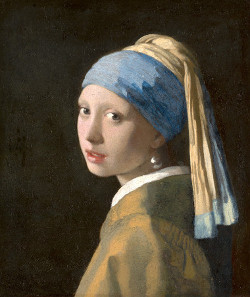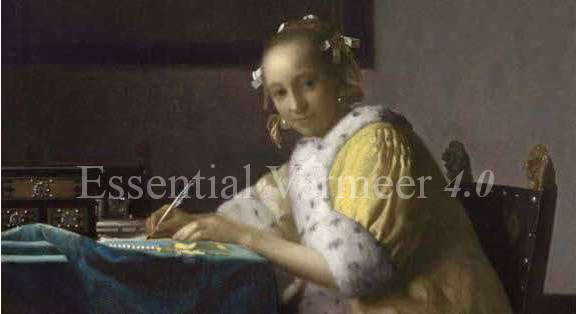Study of a Young Woman
1665–1674Oil on canvas
44.5 x 40 cm. (17 1/2 x 15 3/4 in.)
Metropolitan Museum of Art, New York
In the 1696 sale catalogue of paintings owned by Jacob Dissius, the son-in-law of Vermeer's patron Pieter van Ruijven, "a tronie in antique dress, uncommonly artful" is listed as number 38 and is followed by 39. Another ditto [tronie by] Vermeer," and "4-0. A pendant of the same." Almost any costume with a bolt of material thrown over the shoulder could explain the reference to a figure as in "antique" dress, which meant merely outdated, not necessarily classical. The entire costume in the present painting from the Wrightsman collection or in Girl with a Red Hat, and the headgear in Girl with a Pearl Earring in the Mauritshuis, would have been termed antique by Dutch critics and cataloguers of the seventeenth century, quite as the costumes in Diana and Her Companions could have been so described.
It is more curious that two of the tronien in the Dissius sale were considered pendants. The Wrightsman (fig. 2) [Study of a Young Woman] and Mauritshuis paintings fig. 1 are almost identical in size and are close in composition: the figures are similarly posed against dark backgrounds, and each wears a pearl earring and an elegant scarf that falls behind her head. The models may or may not have been Vermeer's daughters, but neither picture was painted as a portrait. The paintings are studies of expression, physical types, and visual qualities such as the behavior of light. Whether the two canvases were conceived as pendants, which would have been exceptional for tronien, is quite uncertain but cannot be dismissed out of hand. The differences between the pictures are as remarkable as the similarities.
 fig. 1 Girl with a Pearl Earring
fig. 1 Girl with a Pearl EarringJohannes Vermeer
 fig. 2 Study of a Young Woman
fig. 2 Study of a Young WomanJohannes Vermeer
To be sure, the Mauritshuis painting is more immediately appealing, but the Wrightsman picture is equally impressive in its naturalism and perhaps more so in its suggestion of character. The less conventional physiognomy suits the thoughtful, sideward glance and the very different smile; here is no question which young woman would have posed for Christ in the House of Martha and Mary had Vermeer, some years after painting these studies, undertaken to treat again the subject of Christ's visit to the house of his cousins.
 fig. 3 A Woman Writing a Letter (detail)
fig. 3 A Woman Writing a Letter (detail)Frans van Mieris
1680
Oil on panel, 25 x 20 cm.
Rijksmuseum, Amsterdam
As discussed with regard to Girl with a Red Hat the painting of fine materials, with many shifts of color in changing light, was recognized in Vermeer's day as one of the most challenging tests of artistic ability. Masters whom Vermeer admired, in particular Gerrit ter Borch (fig. 4) and Frans van Mieris (fig. 3), were celebrated for their skill in this area. The materials depicted in the present painting are not secondary but essential motifs, meant for the connoisseur's eye and imagination. The coloring of the face and lips accords with that of the costume, in a more muted manner than that found in Girl with a Pearl Earring. The gradual transition from light to shadow on, the young woman's intriguing face, which would probably not respond as well to the strong light employed in the Mauritshuis picture, is in sympathy with the subtle shifts of tone in the drapery. In the other work a contemporary jacket, strongly colored and with faceted folds, provides a solid base for the sculptural head. The modeling, the palette, and the figure's glance have a directness not found in the Wrightsman painting, where the contours are blurred, the shadows are softer, and the highlights are either muted (as in the angular pocket of folds to the lower right) or glisten like a glass mosaic, the staccato pattern of which hints at the weave of luxurious fabric. There is something dreamlike about the illumination in Study of a Young Woman that enhances the sense of disengagement from the viewer in both form and mood. At the bottom of the picture, the resting forearm and back of the wrist represent one of Vermeer's willful elisions of what is known (in this case, anatomy) in favor of what might be seen (depending upon the observer). The flesh tone also slightly enhances the viewer's concentration upon the face.
 fig. 4 Woman Drinking and Holding a Letter (detail)
fig. 4 Woman Drinking and Holding a Letter (detail)Gerrit ter Borch
c. 1665
Oil on canvas, 38.3 x 34 cm.
Sinebrychoff Art Museum, Finnish National Gallery, Helsinki
The prognathous girl (fig. 5) with the widely spaced eyes in the Wrightsman picture in the Metropolitan Museum—a portrait if ever there was one—bears a sufficient resemblance to the young man with the beret (fig. 6) in The Procuress to suggest she may have been the artist's daughter. Vermeer was married in April 1653. His oldest daughter, Maria, could not have been much older than thirteen in 1666.
 fig. 5 left: Study of a Young Woman (detail)
fig. 5 left: Study of a Young Woman (detail)Johannes Vermeer
c. 1665–1674
Oil on canvas, 44.5 x 40 cm.
Metropolitan Museum of Art, New York
fig. 6 right: The Procuress (detail)
Johannes Vermeer
1656
Oil on canvas, 143 x 130 cm.
Gemäldegalerie Alte Meister (Old Masters Picture Gallery), Dresden
1667 or twenty in 1672–1674, the two widely separated dates that Wheelock and Blankert respectively assign to the Wrightsman head. If the head does represent Maria, the latter date must be closer to the truth. It is hardly conceivable that Maria or her younger sister Elisabeth could have been portrayed in the Girl with the Pearl Earring, which is generally dated about 1665 when the older of the two sisters was less than twelve years old.
 Mrs. Jayne Wrightsman, with Vermeer's Study of a Young Woman, in the New York apartment
Mrs. Jayne Wrightsman, with Vermeer's Study of a Young Woman, in the New York apartmentPhoto by Cecil Beaton, Vogue, May 1, 1960 (Cecil Beaton / Vogue; © Condé Nast)






 or anything else that isn't working as it should be, I'd love to hear it! Please write me at:
or anything else that isn't working as it should be, I'd love to hear it! Please write me at: